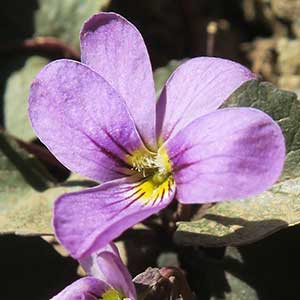Viola flettii
Viola purpurea
Flett's violet, Olympic violet, rock violet
goosefoot violet, mountain violet, pine violet, purple-mark yellow violet
1–3, ascending to erect, mostly glabrous, on caudex from fleshy rhizome.
1–5(–7), decumbent or spreading to erect, leafy proximally and distally, ± glabrous, puberulent, canescent, or tomentose, on caudex from subligneous rhizome.
basal and cauline;
basal: 1–3;
stipules linear-lanceolate, margins entire or with glandular processes, apex acuminate;
petiole 1.5–9.7 cm, mostly glabrous;
blade purple-tinted and –veined, broadly reniform to ovate, 0.9–2.4 × 1.2–4 cm, base cordate, margins finely crenate-serrate, eciliate, apex acute to obtuse, surfaces glabrous or sparsely pubescent along veins adaxially;
cauline similar to basal except: stipules ovate to lanceolate, margins entire or shallowly laciniate;
petiole 0.7–5.9 cm, usually glabrous;
blade 0.8–2.1 × 1.2–3.1 cm.
basal and cauline;
basal: 1–6;
stipules adnate to petiole, forming 2 linear, membranous wings, wing margins entire or laciniate, each wing with lanceolate to ± deltate projection, margins entire or laciniate, apex acute to long-acuminate;
petiole 1.8–14.5 cm, puberulent to tomentose;
blade purplish, purple-tinted, or gray-green abaxially, gray, green, or gray-green adaxially, sometimes shiny adaxially, ovate, orbiculate, oblong, deltate, or lanceolate, 0.8–5.3 × 0.4–4.1 cm, often fleshy, base cordate, subcordate, truncate, or attenuate, oblique or not, margins usually ± crenate, serrate, dentate, or coarsely or irregularly repand-dentate, sometimes entire, usually ciliate, apex acute to obtuse or rounded, surfaces glabrous, puberulent, or tomentose;
cauline similar to basal except: stipules linear, lanceolate, oblanceolate, or ± oblong to ovate, margins entire, lacerate, or laciniate, usually ciliate, apex sometimes divided into 2–3 filiform processes or obtuse;
petiole 0.3–19.7 cm, glabrous or puberulent;
blade ovate, oblong, elliptic, deltate, or lanceolate, 0.9–5.2 × 0.2–2.9 cm, length 0.8–7.1 times width, margins crenate, serrate, dentate, repand-denticulate, undulate-denticulate, sinuate, undulate, or entire, abaxial surface puberulent, canescent, or tomentose, adaxial surface glabrous, sparsely pubescent, puberulent, canescent, or tomentose.
1.8–7.1 cm, usually glabrous.
sepals lanceolate, margins eciliate, auricles 0.5–1.5 mm;
petals soft reddish violet on both surfaces, all with yellow area basally, lower 3 dark violet-veined, lateral 2 bearded, lowest with white around yellow area, 10–15 mm, spur yellow, gibbous, 0.5–2 mm;
style head bearded; cleistogamous flowers axillary.
± spherical, 5–9 mm, glabrous.
ovoid to ± spherical, 4–7 mm, puberulent.
dark brown to brownish purple, 2.5–3 mm.
light to dark brown or mottled gray and brown, 2–3.1 mm.
= 12.
Viola flettii
Viola purpurea
Viola flettii is endemic to the Olympic Mountains of northwestern Washington. C. S. McCreary (2005) noted that although morphologically and ecologically distinct, V. cuneata, V. flettii, and V. ocellata are closely related.
(Discussion copyrighted by Flora of North America; reprinted with permission.)
Varieties 7 (7 in the flora).
Varieties of Viola purpurea are variable and intergrade. All are found in California; six occur in other western states, one in Mexico, and one in British Columbia. Mature plants are needed for determination.
(Discussion copyrighted by Flora of North America; reprinted with permission.)
1. Basal and cauline leaf blade surfaces tomentose | var. aurea |
1. Basal and cauline leaf blade surfaces ± glabrous, canescent, or puberulent | → 2 |
2. Stems mostly buried, not much elongated by end of season; plants 1.5–9(–12) cm | → 3 |
2. Stems usually not buried, usually elongated by end of season; plants 3–25 cm | → 4 |
3. Cauline leaf margins usually entire, sometimes sinuate; basal leaf margins ± crenate to irregularly repand-dentate or entire. | var. integrifolia |
3. Cauline leaf margins usually coarsely crenate or dentate, sometimes ± serrate or ± entire; basal leaf margins coarse-serrate or irregularly dentate or crenate with 2–4 rounded teeth per side | var. venosa |
4. Basal leaf base cordate or truncate | var. dimorpha |
4. Basal leaf base usually attenuate, sometimes subcordate or truncate | → 5 |
5. Cauline leaf blade length 3.2–7.1 times width, margins usually undulate-denticulate, sometimes entire | var. mesophyta |
5. Cauline leaf blade length 1–3 times width, margins with 3–4(–5) pointed or rounded teeth per side or crenate-serrate | → 6 |
6. Basal leaf blade margins irregularly crenate, without pointed or rounded teeth; adaxial surface often shiny. | var. purpurea |
6. Basal leaf blade margins dentate-serrate with 4–5(–6) pointed or rounded teeth per side; adaxial surface not shiny. | var. mohavensis |
- Local floras:
BC,
CA,
OR,
WA
- Local Web sites:
CalFlora,
CalPhotos,
Flora NW,
PNW Herbaria,
Turner Photog.
WildflowerSearch
iNaturalist (observations)
USDA Plants Database
- LBJ Wildflower Center
- SEINet
- Plants of the World Online
- Encyclopedia of Life
- Wikipedia
- Google Image Search


